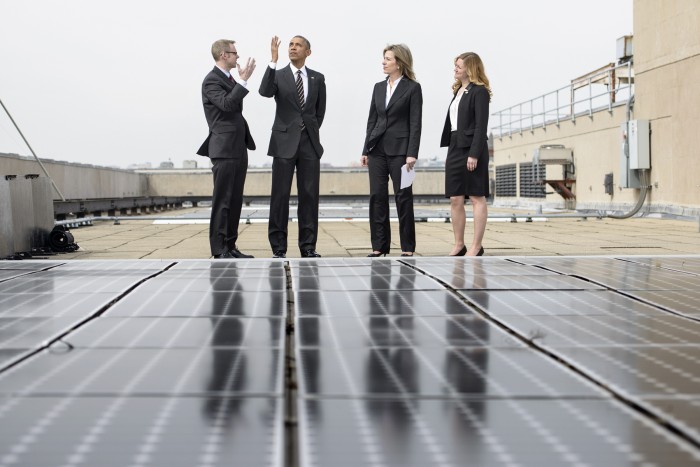Obama Says the World’s Move Toward Renewables Is “Irreversible”
The renewable energy revolution is already under way, and there’s nothing you can do to stop it.
That’s the point President Barack Obama sought to make in a piece published today in Science in which he outlined, as he put it, “the four reasons I believe the trend toward clean energy is irreversible.”
He started off with a biggie. It’s long been received wisdom that economic growth is associated with increased energy usage—which means more greenhouse gas emissions. That’s been true for decades—but since 2008 there has been a dramatic shift in how America gets its energy. As a result, Obama says, the economy grew more than 10 percent from 2008 to 2015 while CO2 emissions fell. This is something we have also observed, and Obama’s assertion that the trend has gone global checks out, too.

In the U.S., most of that is attributable to a large-scale shift away from coal and toward natural gas, whose renaissance is driving coal-fired power plants out of business.
Obama goes on to tout his administration’s work in improving fuel efficiency for vehicles and energy use in home appliances. But perhaps because his piece is in part an appeal to the incoming Trump administration and Republican-led Congress not to mess with a good thing, this is the last we hear about regulation. Everything else is about businesses deciding on their own to increase energy efficiency or make the switch to renewable energy. “Look,” Obama appears to be saying, “The invisible hand of the market is guiding us toward a low-carbon future.”
That’s true, to a point. But things aren’t changing nearly fast enough to forestall some of the worst effects of climate change.
Obama rightly points out that some states, like Texas and Iowa, are benefitting from a boom in wind power, and many others are pushing hard to reduce their reliance on fossil fuels. But his piece misses out on an opportunity to address one of the largest stumbling blocks to widespread adoption of renewable energy: it’s going to take a lot of infrastructure spending to update our energy grids so that they can reliably transport and store energy around the country. Texas provides an interesting case study in this regard, but Obama doesn’t mention it.
And then there’s the Paris agreement. During his campaign for the presidency, Donald Trump said he would back the U.S. out of the landmark climate accord if he were elected. Obama argues that with countries representing 75 percent of the world’s greenhouse gas emissions signed on to reduce their output, there is not only an unprecedented opportunity to curtail climate change—there is peer pressure on the U.S.
In his sign-off, Obama allows that his way of doing things may not be the only path to getting climate change under control; the Trump administration may very well be able to find some other course that will yield the same result. The important thing, he writes, isn’t how the task gets done, only that it does.
(Read more: Science, “Obama’s Drilling Ban Is Just One of Many Forces Pushing the U.S. Toward Renewables,” “Trump’s Empty Promise to Coal Country,” “Carbon Dioxide Emissions Keep Falling in the U.S.”)
Keep Reading
Most Popular
Large language models can do jaw-dropping things. But nobody knows exactly why.
And that's a problem. Figuring it out is one of the biggest scientific puzzles of our time and a crucial step towards controlling more powerful future models.
How scientists traced a mysterious covid case back to six toilets
When wastewater surveillance turns into a hunt for a single infected individual, the ethics get tricky.
The problem with plug-in hybrids? Their drivers.
Plug-in hybrids are often sold as a transition to EVs, but new data from Europe shows we’re still underestimating the emissions they produce.
Stay connected
Get the latest updates from
MIT Technology Review
Discover special offers, top stories, upcoming events, and more.